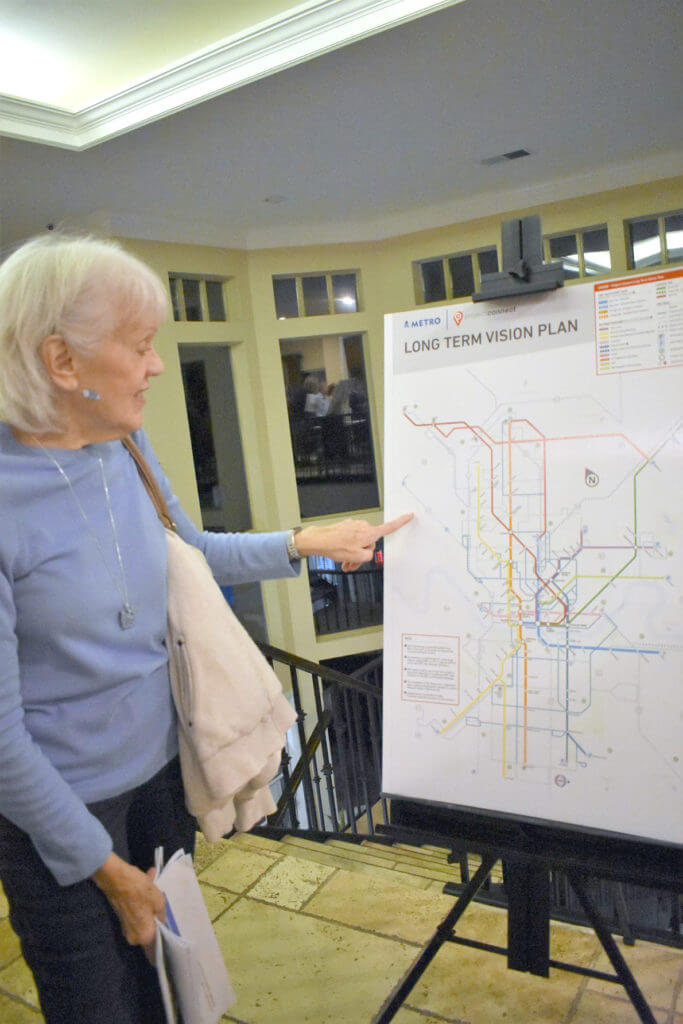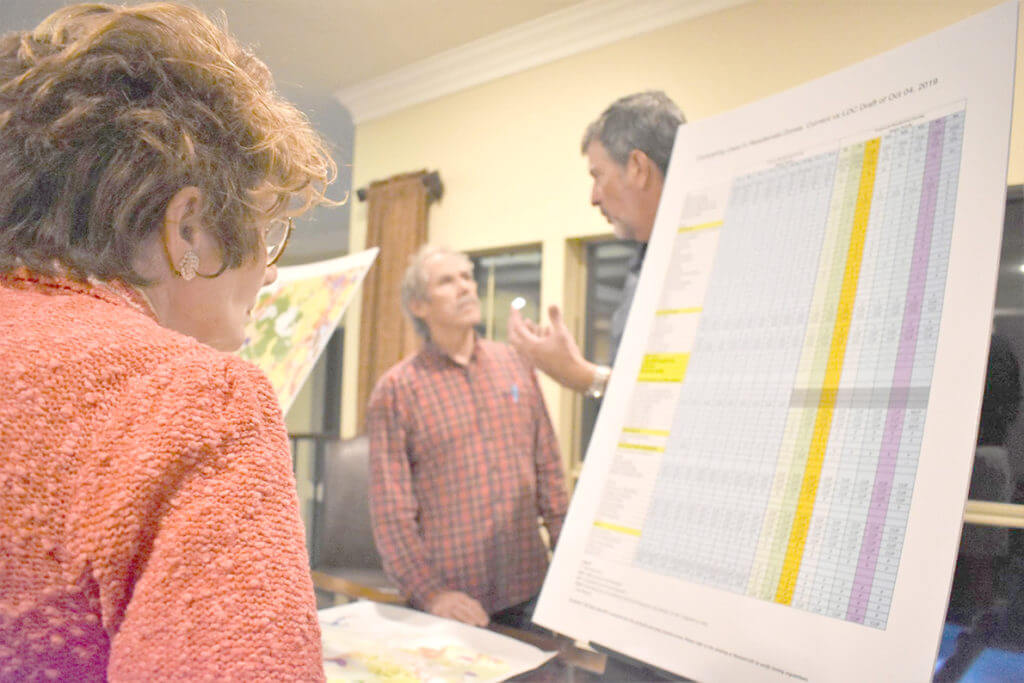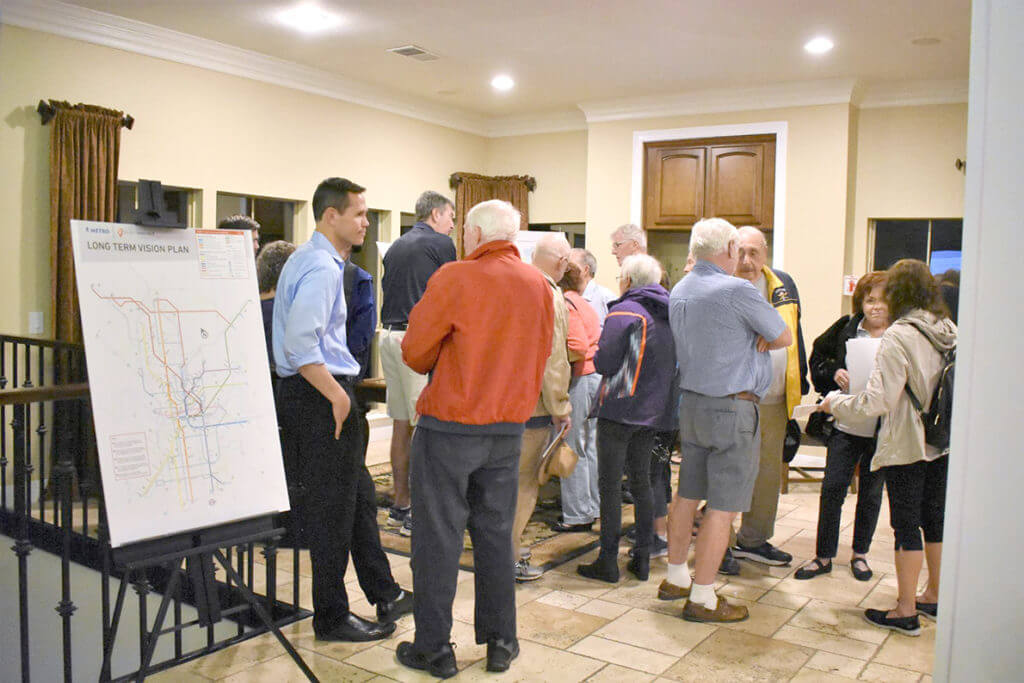
Safety, wildfire concerns cited
By LESLEE BASSMAN, Four Points News
For Long Canyon resident Raezel Poplawski, proposed changes to the city of Austin’s Land Development Code are more than troublesome. The long-time resident called the possible expansion of density within residential housing “criminal” by putting residents in harm’s way should a wildfire breakout.
“I’m very concerned about the public safety issue,” Poplawski said. “We have already inundated the wildlands. We’ve encroached on these properties out here in the wildlands and, quite like California (with its recent widespread wildfires), we are putting the citizenry at risk.”
Poplawski is not alone in her position and was joined by numerous neighbors at the Oct. 24 open house and information sharing event held at the Montevista Condominiums clubhouse off Shepherd Mountain Cove to discuss the proposed code changes. The event was sponsored by the 2222 Coalition of Neighborhood Associations, a nonprofit organization that focuses on development and zoning changes affecting communities along and near RM 2222.
Most of the communities down City Park Road in the northwest section of Austin have only a single accessway, including Long Canyon that has about 350 homes. By adding density to the properties and with the limited access to the area, residents at the event said a wildfire would create a life or death situation for their families.
“This is a wildlands urban interface, or WUI, and anybody who lives here is at risk,” Poplawski said of the area where houses meet undeveloped wildland vegetation. “We have to be good stewards of our environment and thinking about the lives of each and every person who lives here. To bring more people into this already densely-populated area is just inviting more risk and danger.”
Tom Smith, president of 2222 CONA and a resident of Long Canyon, said the group aimed to be “unbiased brokers of the information to people,” hoping to educate local residents and help them become aware of the proposed changes.
According to CONA, the Austin Land Development Code is one of the ways the city will implement its vision outlined in the Imagine Austin Comprehensive Plan. The code’s changes propose to improve affordability in Austin housing by allowing increased density on existing lots; provide incentives through additional units and building height to developers who will sell or rent homes to eligible households at capped rates; and increase citywide housing capacity and inventory.
Specifically, Smith said the most impactful code change for Four Points-area residents is the proposal that will increase the maximum units per lot to three units on most lots.
If a neighboring home sells and the buyer wants to make the parcel into an investment property and upgrade to the proposed maximum units allowable by city code, they can get a building permit allowing this change, he said. However, this proposed provision may be in direct conflict in areas with a homeowners association that has a covenant, code or restriction running with the site and providing only one home per lot, he said.
“If this revision passes, what it does is create a huge potential legal liability for homeowners associations to take on because now they have to fight if there’s a vacant lot and an investor obtains a building permit for a duplex from the city of Austin, a structure not permitted by the community’s deeds, covenants, codes and restrictions within the homeowners association,” Smith said. “This time (the city code) and (the homeowners associations) are in conflict.”
He said the city won’t enforce a homeowners association code, leaving the association to battle the issue.
Other proposed development changes include:
- Allowing more housing types and density on residential lots, including duplexes, townhomes and accessory dwelling units such as a mother-in-law suite or casita
- Reducing the minimum lot size on most tracts
- Allowing multi family use in all commercial zones
- Adding more affordable and income restricted housing
- Requiring less parking
- Promoting high housing density on busy streets
- Maintaining environmental protections for trees and flooding
- Maintaining the Hill Country Road Ordinance
- Easing the ability to subdivide lots.
“I don’t see a situation for people in our neighborhoods who are going to upgrade their homes into duplexes,” Smith said. “If a property sells or if you have homes in your area that are leased homes—the owners don’t live in your neighborhood—they can say, ‘I’m getting X rent now (and) I can double that by turning it into a duplex on that same piece of land.’”
He said investors would be motivated by this proposal to at least look at the financial profit of such an increase in units on a lot. Vacant land can also be impacted, he said.
Long Canyon has an undeveloped parcel and Smith said he is concerned that a multifamily structure can be constructed in the middle of the single family community. River Place could also be faced with this scenario as it was annexed by the city of Austin a couple of years ago.
Smith said the proposal doesn’t take into account the threat of wildfire in the western Travis County area along with its environmental protection for trees and flooding. He said this risk is exacerbated by the low water pressure in some of these communities, such as Long Canyon, because it is geographically at a high point in the area.
“There’s real challenges there,” Smith said.
He pointed out the development guidelines proposed are meant for “matrix streets downtown with public transportation options,” with the City Park region lacking both the stated roadway configuration and mass transit.
Glenlake’s Linda Bailey shares Smith’s sentiments. She said many of the lots in her neighborhood—that was built out 30 years ago—include two acres, providing for multiple homesites on the tracts under the proposed code changes. And, many more cars and people, she said.
“Right now we have just one acre with a family of four,” Bailey said. “So, it is a huge impact and we don’t have the infrastructure for it, we don’t have the roads for it and we don’t have the safety from wildfire or traffic.”
Transportation upgrades are also being discussed but some residents said the model doesn’t serve the RM 2222 area.
“(RM 2222) is the only east-west corridor that has to handle all of the traffic from (RM) 620 and it has to continue to support and feed all of this transit plan,” Poplawski said. “Now they want to make this a high density housing zone and we can’t even handle what already exists.”
Melody Strozewski, who lives in the Montevista complex, said she moved to Austin 20 years ago because it was “a quiet town,” big enough for her to feel like she lived in a city but small enough so she wouldn’t waste too much time driving in traffic.
“Definitely things have changed,” she said. “Seeing we can have more houses invites more people to Austin. It makes me sad because it will be more crowded and more expensive. But, on the other hand, it’s growth for the city. We’ll have more smart people and (a good) economy is good for the city.”
Bruce Byron, Texas Department of Transportation’s public involvement lead, said the biggest improvement for RM 2222 communities will come when the intersections of RM 620 and Loop 360 are improved. He said the agency has planned a diverging diamond model at Loop 360 and RM 2222 that increases capacity by 30-50%. An overpass at The Courtyard at the Loop 360 intersection is also in the works, eliminating lights on Loop 360 to avoid the traffic backup that currently exists, he said.
“(RM) 2222 is basically a straight shot, four lanes or five lanes depending on where you are, and there’s not much additional growth that will be going alongside (RM) 2222 in this area,” Byron said. “If we can get the intersections cleared out, it will help a lot.”
The Westlake section of the Loop 360 corridor will begin in 2022 and various projects along this corridor will continue for a decade afterwards, he said. The Courtyard project at Loop 360 is third on the list of corridor improvements and may begin around 2024, he said.
Denise Hogan, a Courtyard resident and member of the community’s board of trustees, said she wants to have a “heads up” look at what’s coming for her area. She said her concern includes the new density rules and rezoning formats that may affect the region.
“We’re really trying to work together in District 10, each of the individual neighborhoods,” Hogan said. “We are trying to educate ourselves and present ourselves as an educated voice. We’re trying to look ahead and plan for what’s coming in the future—to help shape conversations around where we would like to see different types of development in District 10 because we know District 10 is a target for more density and for more development.”
District 10 Council Member Alison Alter held a Town Hall on the Land Development Code on Oct. 21 and has been attending as many neighborhood meetings on this issue as possible, Communications and Outreach Coordinator April Brown said.
Whereas Alter, who voted against the code revision process, is in favor of increasing density along designated activity corridors and within activity centers, “the adopted approach relies too heavily on rapidly unleashing the market and expecting the kind of development in Imagine Austin to follow,” according to a recent newsletter.
“Such mapping would increase development entitlements in some single family neighborhoods,” Alter stated in the newsletter.
The 2222 CONA group hasn’t provided an official statement on the proposal yet, with its efforts centered on getting its information out to the local public.
In early-November, the city’s commission on the plan will consider the proposed changes before the document reaches Austin City Council in the middle of the month for a public hearing. Council will consider approving the measure in early December at its first reading.



